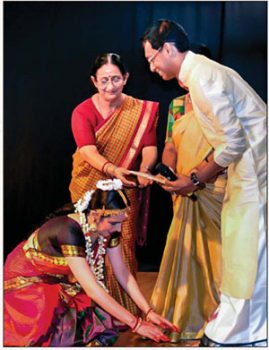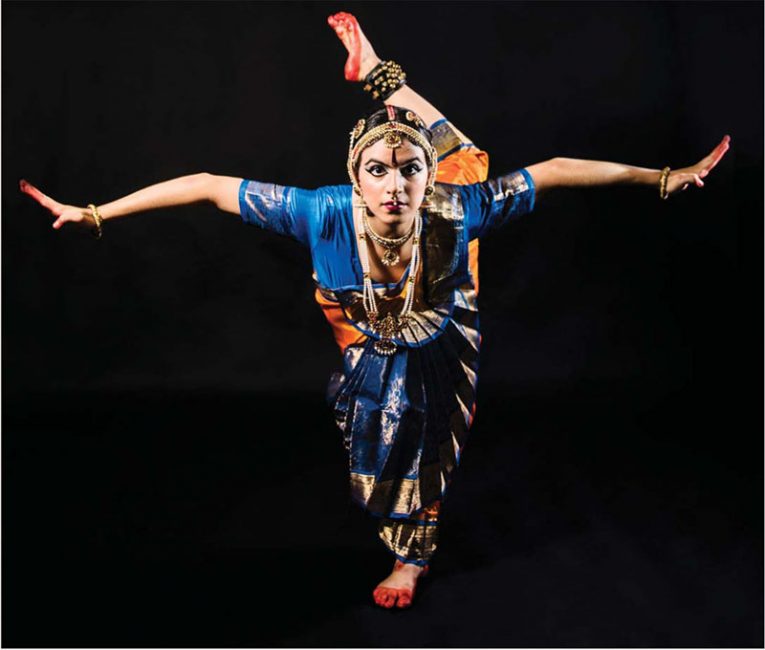Ananga Manjari Malatesta Gonzalez, born in South America with a Hindu heart, reaches the world stage to share her passion for Indian spiritual culture
BY LAVINA MELWANI, NEW YORK
HER MOTHER IS PERUVIAN AND HER father is Italian, but Ananga’s heart is Indian to the core. This young Peruvian has lived in many countries and imbibed their cultures, but her soul is Hindu and her passion is Indian classical dance. She particularly loves Bharatanatyam, which she started studying at the age of four, along with classical ballet, tango and flamenco.
Thousands of miles from India, Ananga, now a university student, has become an accomplished Bharatanatyam dancer. She has performed in many South American countries, Malaysia and India. Now she teaches many young Peruvians at her dance school, Gopesvara Arts.
For this love of dance, she has both her parents to thank. Her father is an artiste who had studied trumpet and piano and had traveled to Europe and India. Her mother was born in Lima, Peru, and was always a dancer, learning ballet, as well as Western classical flute, at the conservatory. Both parents converted to Hinduism before their daughter’s birth; so Ananga, born in Cochabamba, Bolivia, is a born Hindu. Later they moved to Columbia and finally to Peru.
Hinduism was very much a part of their life from the beginning, with a home shrine, bhajans and the glow of the dipam. This was not common in Peru. She says, “More than Hinduism, being vegetarian was strange to everyone in the school. I was a born vegetarian. South America is a meat eaters’ culture, so trying to explain why I am vegetarian was always a topic in any conversation I had. Peru has a variety of vegetables, fruits and cereals, which makes it easier for a vegetarian. At the same time, my schoolmates were fascinated by the Indian culture, which made it easy for me to make friends who understand my way of life and respect it.”
Ananga’s earliest memories of dance are learning from her mother. “My mother was very attached to discipline, so I had a teacher both in and out of class, which made me progress faster.” When she was just four, Ananga’s mother wanted her to learn a spiritual art form, so in Colombia she located an academy named Four Elements that taught basic theory. Not wanting to send her daughter alone to the class, her mother took the class with her and became completely captivated. Ananga’s father bought them CDs in Sanskrit and as many books as they could find online.
“At that time in Peru we had no teacher, and there was no YouTube or Facebook,” recalls Ananga. “Mother used to study every day, and she even translated to Spanish a small Natyashastra book, Abhinaya Darpana. She started teaching dance in 2001 for one student, then eight. She worked hard and would be in the dance room five hours a day. I finally left regular school to be home schooled, so dance became a major part of my day.”
Ananga and her mother were avid devotees of Bharatanatyam. When she was 13, she and her mother went to Montreal, Canada, on a scholarship given by Dr. Mamata Niyogi-Nakra. In 2012, Guru Shankar Kandasamy, head of the Bharatanatyam department at Temple of Fine Arts in Malyasia, came to Peru. He trained 17 students, which culminated in a performance that Ananga says she will never forget: “It was the first time we performed with an Indian guru.” She performed her first major repertoire, “Marga Anjali,” under the guidance of Kandasamy, and was bestowed the title of Yogyata Patra.
How important is dance to Ananga’s spiritual quest? “Dance is Natya Yoga, and for me it is a very vital part of my spirituality. We learn about traditions, language, Vedas. It’s one way of praying and remembering God; it keeps me interested in the lives of poets and saints and reminds me that we are not this body. For me dance is the way I express myself and feel connected with the Divine.”
Since 2001 Ananga and her mother have run a dance school in Peru, called Gopesvara Dance. They recently converted this to a nonprofit organization, Gopesvara Arts.
As Ananga points out, “This took time, because in Peru the public connected Indian dance with Bollywood. They did not understand the deeper significance of Bharatanatyam. So to explain to them, we performed in many poor places, big and small theaters. Sharing our traditions, we found stories from our Vedas and philosophy are very attractive for Peruvians. Of course, adding the make-up and jewelry makes it even more attractive!”

Local Indians have helped Ananga and her mother spread Indian classical dance. Ananga has special regard for Geetu Chugani, “who has been helping us for more than seven years and has been like a mother to me. She has also helped students who couldn’t afford classes, organizing programs, receiving artistes and supporting many other activities we have, and offering emotional support in our journey.”
Ananga says her father was her first big supporter. He encouraged them to hold festivals and share Carnatic music, shouldering all the expenses. She says, “We say God’s blessings come through people. Father is a blessing for me, my family, and Indian arts in Peru.”
Ananga and the Peruvian community have had strong allies in the Indian High Commission, where the Ambassador Sandeep Chakravorty (now the Consul General in New York) took an active role in bringing Indian culture to the local population. In fact, his own daughter Nandini was Ananga’s student. By inviting many prominent dance teachers to Peru, he made the Indian Embassy a fertile place for arts and culture. Recalls Ananga: “He has been one of the best promoters of Indian classical dance in Peru and Bolivia. He opened a cultural center in the embassy and helped us by conducting performances and inviting prestigious dancers like Guru Shankar Kandasamy, Dr. Janaki Rangarajan, Sarita Mishra (Odissi) and Dr. Bipul Kumar (santoor player).”

Storytelling through Bharatanatyam: Girl waiting for her beloved

Recently things came full circle when Ananga came to New York and performed at the Indian Consulate along with her student Nandini, amazing audiences with how the beauty of Bharatanatyam had flowered in Peru.
Spirituality is a big part of Bharatanatyam. While explaining the poems and philosophy, Ananga tries to convey the emotional connections to her students who may not be Hindu: “We try to find connections with their own culture and tradition. To teach principles and meditation helps students a lot, not only in dance, but in general—and that is our happiness!”
Indeed, it is all about sharing. Says Ananga, “To trust each other and give respect is most important. I think our community becomes stronger when we aren’t judging where we come from, what is our tradition, economy or spiritual beliefs. As a teacher, I consider it my responsibility to think how to help them understand Bharatanatyam with respect to their lives and beliefs.”
Ananga, currently a university student, says, “I try to begin my day with prayers and puja. This helps me to focus and be at ease with a changing campus schedule. But dance practice and teaching is always a part of me.”
She has learned from some noted dance gurus—Padma Bhushan Sonal Mansingh, Janaki Rangarajan and Indira Kadambi, as well as her own guru. She says, “They are all artistes who passionately love what they do—sadhana is their life. When they perform, you see a happy soul dedicating everything on stage! I am always fascinated by their passion, strong minds and character. “

She adds, “The first time I went to India, for me it was like a dream. To see the artists was like meeting a superstar, and to experience such a vast ocean of Bharatanatyam! My experience with them has been amazing—sometimes I wish I had two brains so I won’t forget even a word they have said. I only pray I can have the strength and charisma they have, and realize their words in this life.”
Ananga has been bestowed honors for her dance excellence, but it has been a long hard journey. “When I started dance with my mother, we struggled a lot, not just to get the knowledge but to get everything needed for Bharatanatyam, like jewelry, music and costumes—and even to understand the meanings! We used to send the lyrics to India and get them translated word by word.”
All this has made Ananga a strong dancer and a devotee who knows the value of dance. She is so determined to share her knowledge with people who want to learn that she gives scholarships to those who cannot afford to pay: “People always tell us to charge and make money, but we don’t have the soul to do it. Bharatanatyam is a spiritual dance; how can we make a profit from it and make people who want to learn go through the same struggle as we did?”
She adds, “I have traveled many times to teach and perform, only asking organizers to cover my ticket and accommodation. I know what it means to have the passion to learn and not have the chance to do it because of lack of money or being far from a teacher. Being far from India or Malaysia is always a challenge, but Mother is always trying to help me, and of course I love to dance, so I pray what I’m practicing is correct, trying to get the blessings of God.”
LAVINA MELWANI is a New York based journalist for several international publications. She blogs at “Lassi with Lavina.”
Follow her @lavinamelwani
